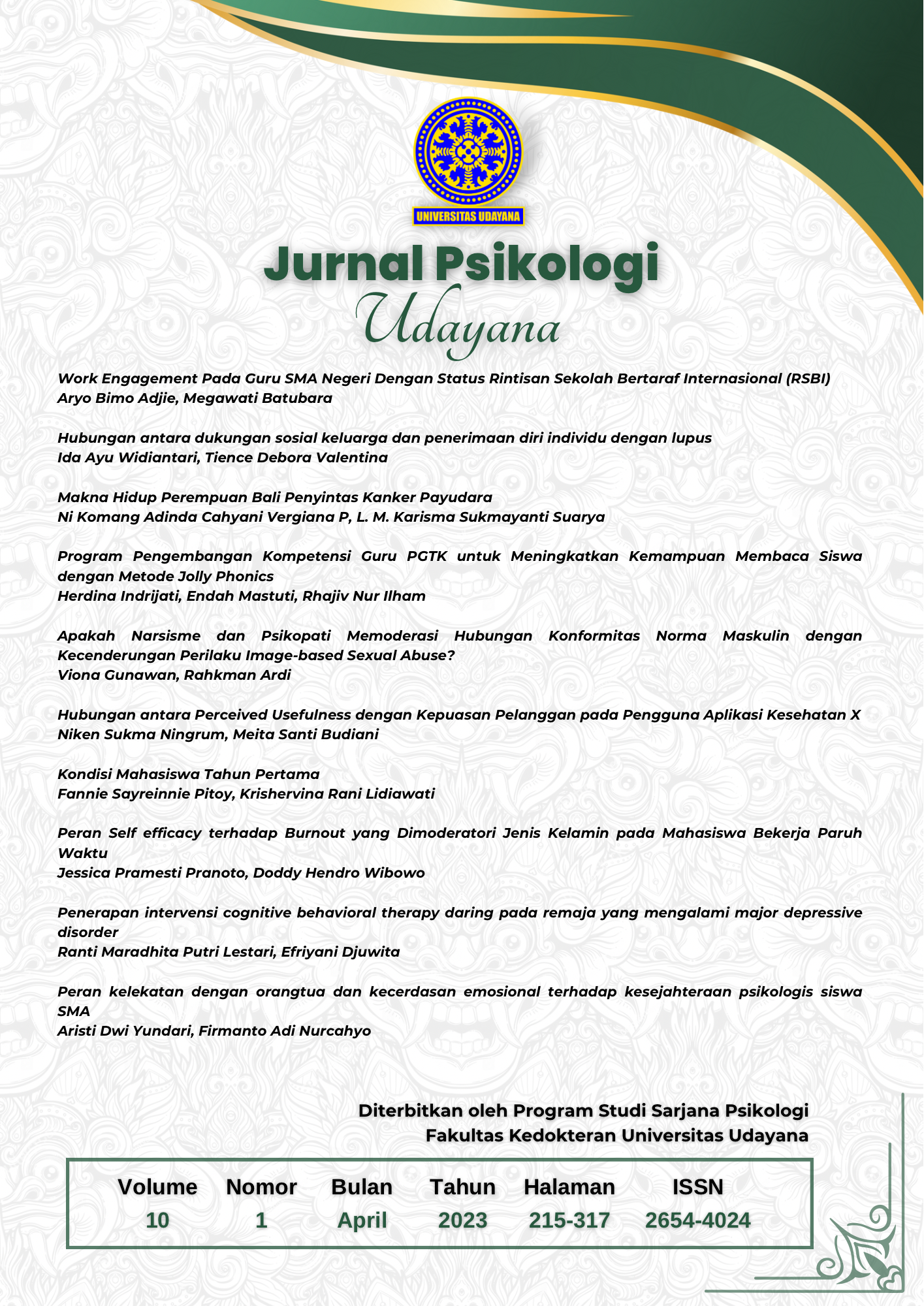Apakah Narsisme dan Psikopati Memoderasi Hubungan Konformitas Norma Maskulin dengan Kecenderungan Perilaku Image-based Sexual Abuse?
Abstract
Dalam beberapa tahun terakhir, image-based sexual abuse (IBSA), terutama penyebaran konten grafis seksual secara non-konsensual marak terjadi di Indonesia. Beberapa studi kualitatif menyatakan bahwa terjadinya IBSA didasari oleh mengakarnya budaya patriarki dan norma gender yang menekankan bahwa laki-laki berkuasa dibandingkan perempuan. Oleh karenanya, peneliti menggali peran konformitas terhadap norma maskulin, utamanya pada norma “kuasa di atas perempuan” pada kecenderungan perilaku IBSA. Namun, hubungan antara konformitas terhadap norma maskulin dengan kecenderungan perilaku IBSA, dapat berbeda berdasarkan karakteristik individu. Individu yang tinggi dalam karakteristik kepribadian narsisme dan psikopati, memiliki kecenderungan yang lebih tinggi untuk melakukan IBSA. Penelitian ini dilakukan untuk mengetahui efek moderasi narsisme dan psikopati pada hubungan antara konformitas terhadap norma maskulin dengan kecenderungan perilaku IBSA. Partisipan survei ini terdiri dari 237 orang yang berusia 18-39 tahun dan bertempat tinggal di Indonesia. Analisis data dilakukan menggunakan teknik analisis moderasi dengan metode bootstrap. Hasil analisis menunjukkan bahwa konformitas terhadap norma maskulin berefek positif pada kecenderungan perilaku IBSA. Selain itu, ditemukan bahwa psikopati memoderasi hubungan konformitas terhadap norma maskulin dengan kecenderungan perilaku IBSA sedangkan narsisme tidak memoderasi hubungan tersebut.
Downloads
References
Beaton, D. E., Bombardier, C., Guillemin, F., & Ferraz, M. B. (2000). Guidelines for the Process of Cross-Cultural Adaptation of Self-Report Measures: Spine, 25(24), 3186–3191. https://doi.org/10.1097/00007632-200012150-00014
Field, A. (2018). Discovering statistics using IBM SPSS statistics(5th edition). SAGE Publications.
Glenn, A. L., Iyer, R., Graham, J., Koleva, S., & Haidt, J. (2009). Are All Types of Morality Compromised in Psychopathy? Journal of Personality Disorders, 23(4), 384–398. https://doi.org/10.1521/pedi.2009.23.4.384
Hall, M., & Hearn, J. (2019). Revenge pornography and manhood acts: A discourse analysis of perpetrators’ accounts. Journal of Gender Studies, 28(2), 158–170. https://doi.org/10.1080/09589236.2017.1417117
Hansen Mandau, M. B. (2020). Homosocial positionings and ambivalent participation: A qualitative analysis of young adults’ non-consensual sharing and viewing of privately produced sexual images. MedieKultur: Journal of Media and Communication Research, 36(67), 055–075. https://doi.org/10.7146/mediekultur.v36i67.113976
Hare, R. D., & Neumann, C. S. (2008). Psychopathy as a Clinical and Empirical Construct. Annual Review of Clinical Psychology, 4(1), 217–246. https://doi.org/10.1146/annurev.clinpsy.3.022806.091452
Hayes, A. F. (2022). Introduction to Mediation, Moderation, and Conditional Process Analysis: A Regression-Based Approach(3rd ed.). The Guilford Press.
Henry, N., Flynn, A., & Powell, A. (2019). Image-based sexual abuse: Victims and perpetrators. 20.House, R. J., & Howell, J. M. (1992). Personality and charismatic leadership. The Leadership Quarterly, 3(2), 81–108. https://doi.org/10.1016/1048-9843(92)90028-E
Johnson, A. G. (2004). Patriarchy, The System. In Women’s Lives Multicultural Perspectives(Vol. 3, pp. 25–32).
Karasavva, V., & Forth, A. (2021). Personality, Attitudinal, and Demographic Predictors of Non-consensual Dissemination of Intimate Images. Journal of Interpersonal Violence, 088626052110435. https://doi.org/10.1177/08862605211043586
KOMNAS Perempuan. (2022). Bayang-bayang Stagnansi: Daya Pencegahan dan Penanganan Berbanding Peningkatan Jumlah, Ragam dan Kompleksitas Kekerasan Berbasis Gender terhadap Perempuan. https://komnasperempuan.go.id/siaran-pers-detail/peringatan-hari-perempuan-internasional-2022-dan-peluncuran-catatan-tahunan-tentang-kekerasan-berbasis-gender-terhadap-perempuanLBH Apik Jakarta. (2021). Kekerasan Terhadap Perempuan Meningkat, Negara Wajib Memberikan Ruang Aman: Catatan Akhir Tahun LBH Apik Jakarta Berdasarkan Pengalaman Penanganan Kasus dan Advokasi 2021. https://drive.google.com/file/d/184JB9O9OUFPSkjvgJ90e9oIVfRoYN-7x/view
Locke, B. D., & Mahalik, J. R. (2005). Examining Masculinity Norms, Problem Drinking, and Athletic Involvement as Predictors of Sexual Aggression in College Men. Journal of Counseling Psychology, 52(3), 279–283. https://doi.org/10.1037/0022-0167.52.3.279
Maas, M. K., Cary, K. M., Clancy, E. M., Klettke, B., McCauley, H. L., & Temple, J. R. (2021). Slutpage Use Among U.S. College Students: The Secret and Social Platforms of Image-Based Sexual Abuse. Archives of Sexual Behavior, 50(5), 2203–2214. https://doi.org/10.1007/s10508-021-01920-1
Mahalik, J. R., Locke, B. D., Ludlow, L. H., Diemer, M. A., Scott, R. P. J., Gottfried, M., & Freitas, G. (2003). Development of the Conformity to Masculine Norms Inventory. Psychology of Men & Masculinity, 4(1), 3–25. https://doi.org/10.1037/1524-9220.4.1.3
March, E., Grieve, R., Clancy, E., Klettke, B., van Dick, R., & Hernandez Bark, A. S. (2021). The Role of Individual Differences in Cyber Dating Abuse Perpetration. Cyberpsychology, Behavior, and Social Networking, 24(7), 457–463. https://doi.org/10.1089/cyber.2020.0687
Moor, L., & Anderson, J. R. (2019). A systematic literature review of the relationship between dark personality traits and antisocial online behaviours. Personality and Individual Differences, 144, 40–55. https://doi.org/10.1016/j.paid.2019.02.027
Naezer, M., & van Oosterhout, L. (2021). Only sluts love sexting: Youth, sexual norms and non-consensual sharing of digital sexual images. Journal of Gender Studies, 30(1), 79–90. https://doi.org/10.1080/09589236.2020.1799767
Parent, M. C., & Moradi, B. (2009). Confirmatory factor analysis of the Conformity to Masculine Norms Inventory and development of the Conformity to Masculine Norms Inventory-46. Psychology of Men & Masculinity, 10, 175–189. https://doi.org/10.1037/a0015481
Paulhus, D. L., & Williams, K. M.(2002). The Dark Triad of personality: Narcissism, Machiavellianism, and psychopathy. Journal of Research in Personality, 36(6), 556–563. https://doi.org/10.1016/S0092-6566(02)00505-6
Peterson, C. H., Peterson, N. A., & Powell, K. G. (2017). Cognitive Interviewing for Item Development: Validity Evidence Based on Content and Response Processes. Measurement and Evaluation in Counseling and Development, 50(4), 217–223. https://doi.org/10.1080/07481756.2017.1339564
Pina, A., Holland, J., & James, M. (2017). The Malevolent Side of Revenge Porn Proclivity: Dark Personality Traits and Sexist Ideology. International Journal of Technoethics, 8(1), 30–43. https://doi.org/10.4018/IJT.2017010103
Polit, D. F., & Beck, C. T. (2006). The content validity index: Are you sure you know what’s being reported? critique and recommendations. Research in Nursing & Health, 29(5), 489–497. https://doi.org/10.1002/nur.20147
Poteat, V. P., Kimmel, M. S., & Wilchins, R. (2011). The Moderating Effects of Support for Violence Beliefs on Masculine Norms, Aggression, and Homophobic Behavior During Adolescence: MASCULINE NORMS AND AGGRESSION. Journal of Research on Adolescence, 21(2), 434–447. https://doi.org/10.1111/j.1532-7795.2010.00682.x
Powell, A., & Henry, N. (2017). Sexual Violence in a Digital Age. Palgrave Macmillan UK. https://doi.org/10.1057/978-1-137-58047-4
Powell, A., Henry, N., Flynn, A., & Scott, A. J. (2019). Image-based sexual abuse: The extent, nature, and predictors of perpetration in a community sample of Australian residents. Computers in Human Behavior, 92, 393–402. https://doi.org/10.1016/j.chb.2018.11.009
Powell, A., Scott, A. J., Flynn, A., & Henry, N. (2020). Image-based sexual abuse: An international study of victims and perpetrators. https://doi.org/10.13140/RG.2.2.35166.59209
Rauthmann, J. F., & Kolar, G. P. (2012). How “dark” are the Dark Triad traits? Examining the perceived darkness of narcissism, Machiavellianism, and psychopathy. Personality and Individual Differences, 53(7), 884–889. https://doi.org/10.1016/j.paid.2012.06.020
Reed, L. A., Tolman, R. M., & Ward, L. M. (2016). Snooping and Sexting: Digital Media as a Context for Dating Aggression and Abuse Among College Students. Violence Against Women, 22(13), 1556–1576. https://doi.org/10.1177/1077801216630143
Ringrose, J., Harvey, L., Gill, R., & Livingstone, S. (2013). Teen girls, sexual double standards and ‘sexting’: Gendered value in digital image exchange. Feminist Theory, 14(3), 305–323. https://doi.org/10.1177/1464700113499853
Ringrose, J., Regehr, K., & Whitehead, S. (2022). ‘Wanna trade?’: Cisheteronormative homosocial masculinity and the normalization of abuse in youth digital sexual image exchange. Journal of Gender Studies, 31(2), 243–261. https://doi.org/10.1080/09589236.2021.1947206
Rogoza, R., Żemojtel-Piotrowska, M., Jonason, P. K., Piotrowski, J., Campbell, K. W., Gebauer, J. E., Maltby, J., Sedikides, C., Adamovic, M., Adams, B. G., Ang, R. P., Ardi, R., Atitsogbe, K. A., Baltatescu, S., Bilić, S., Bodroža, B., Gruneau Brulin, J., Bundhoo Poonoosamy, H. Y., Chaleeraktrakoon, T., ... Włodarczyk, A. (2021). Structure of Dark Triad Dirty Dozen Across Eight World Regions. Assessment, 28(4), 1125–1135. https://doi.org/10.1177/1073191120922611
SAFEnet. (2022). Laporan Situasi Hak-hak Digital Indonesia 2021: Pandemi Memang Terkendali, Tetapi Represi Digital Terus Berlanjut. https://awaskbgo.id/wp-content/uploads/2022/03/Laporan-Situasi-Hak-Digital-2021-Part-KBGO.pdf
Seabrook, R. C., Ward, L. M., & Giaccardi, S. (2018). Why is fraternity membership associated with sexual assault? Exploring the roles of conformity to masculine norms, pressure to uphold masculinity, and objectification of women. Psychology of Men & Masculinity, 19(1), 3–13. https://doi.org/10.1037/men0000076
Sperber, A. D. (2004). Translation and validation of study instruments for cross-cultural research. Gastroenterology, 126, S124–S128. https://doi.org/10.1053/j.gastro.2003.10.016
Van Ouytsel, J., Walrave, M.,De Marez, L., Vanhaelewyn, B., & Ponnet, K. (2021). Sexting, pressured sexting and image-based sexual abuse among a weighted-sample of heterosexual and LGB-youth. Computers in Human Behavior, 117, 106630. https://doi.org/10.1016/j.chb.2020.106630
Zuo, S., Wang, F., Xu, Y., Wang, F., & Zhao, X. (2016). The fragile but bright facet in the Dark Gem: Narcissism positively predicts personal morality when individual’s self-esteem is at low level. Personality and Individual Differences, 97, 272–276. https://doi.org/10.1016/j.paid.2016.03.076

This work is licensed under a Creative Commons Attribution-ShareAlike 4.0 International License.
Authors who publish with this journal agree to the following terms:
- Authors retain copyright and grant the journal right of first publication with the work simultaneously licensed under a Creative Commons Attribution-ShareAlike 4.0 International License that allows others to share the work with an acknowledgement of the works authorship and initial publication in this journal.
- Authors are able to enter into separate, additional contractual arrangements for the non-exclusive distribution of the journals published version of the work (e.g., post it to an institutional repository or publish it in a book), with an acknowledgement of its initial publication in this journal.
- Authors are permitted and encouraged to post their work online (e.g., in institutional repositories or on their website) prior to and during the submission process, as it can lead to productive exchanges, as well as earlier and greater citation of published work (See The Effect of Open Access).













